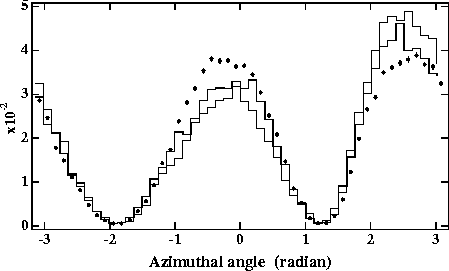
Figure 9:
Azimuthal angular distributions measured for 6< r < 7cm at z=+1m
for vertical displacements of ![]() =
=![]() (solid line),
(solid line), ![]() (dotted line)
compared with the nominal one (solid circles). The distributions are
normalized by the total number of particles.
(dotted line)
compared with the nominal one (solid circles). The distributions are
normalized by the total number of particles.
When two beams collide with a finite vertical
displacement(![]() ) comparable to
) comparable to ![]() , we expect a
vertical, i.e. up-down, asymmetry in the azimuthal angular
distribution. In the simulation beam-1 and beam-2 are initially
shifted by
, we expect a
vertical, i.e. up-down, asymmetry in the azimuthal angular
distribution. In the simulation beam-1 and beam-2 are initially
shifted by ![]() and
and ![]() , respectively. We
examined the two cases of
, respectively. We
examined the two cases of ![]() and
and ![]() , and plotted the angular distribution in
Fig.9. (The luminosity losses are 6 and 30% for
, and plotted the angular distribution in
Fig.9. (The luminosity losses are 6 and 30% for
![]() and
and ![]() ,
respectively.) Apparently, during a collision the particles are
deflected more in the upper side of the electromagnetic field of
beam-2, since they are created in the overlapping region between two
beams. Therefore, they are deflected more in +y and less in -y
than in the nominal case, as can be clearly seen in
Fig.9. The ratios
,
respectively.) Apparently, during a collision the particles are
deflected more in the upper side of the electromagnetic field of
beam-2, since they are created in the overlapping region between two
beams. Therefore, they are deflected more in +y and less in -y
than in the nominal case, as can be clearly seen in
Fig.9. The ratios ![]() are found to be 0.76 and
0.62 for
are found to be 0.76 and
0.62 for ![]() =
=![]() 0.5
0.5 ![]() and
and
![]() 1
1![]() , respectively.
, respectively.